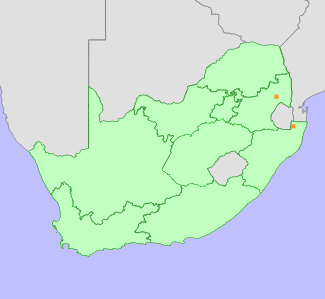|
Scientific Name | Gymnosporia swazica Jordaan |
Higher Classification | Dicotyledons |
Family | CELASTRACEAE |
Common Names | Lemoendoring (a) |
National Status |
Status and Criteria | Vulnerable D1+2 |
Assessment Date | 2023/02/01 |
Assessor(s) | H. Mtshali & M. Jordaan |
Justification | This range-restricted species has an extent of occurrence (EOO) of 751 km², and an area of occupancy (AOO) of 16 km². It is known from three locations in South Africa and two locations in Eswatini, where it is potentially threatened by habitat loss to agriculture and infrastructure development. The population is estimated to be very small (<1000 mature individuals). The subpopulation in Mpumalanga occurs over 100 km away from the Eswatini subpopulations, where the condition of this species is unknown. Therefore, the national status is not adjusted following the IUCN regional assessment guidelines. This species is therefore listed as Vulnerable under criterion D. |
Distribution |
Endemism | Not endemic to South Africa |
Provincial distribution | KwaZulu-Natal, Mpumalanga |
Range | This species has a restricted distribution in southern Africa, where it has scattered localities in South Africa in Mpumalanga and north-eastern KwaZulu-Natal, through to the Lebombo mountains of Eswatini. |
Habitat and Ecology |
Major system | Terrestrial |
Major habitats | Granite Lowveld |
Description | This shrub or small tree grows as an understorey in forest, on hillsides often among granite boulders near streams. |
Threats |
| At least 11% of this species' habitat is irreversibly modified due to agriculture. There are, however, no direct threats known to impact subpopulations of this species. The area where this species is found is not protected in Mpumalanga and KwaZulu-Natal, and it is likely the same in Eswatini.
Some species of Gymnosporia are used in traditional medicine, but the uses of this species are unknown. |
Population |
Very limited population status data are available for this species both in South Africa and Eswatini, but it seems to be rare as it is known from only eight collections. The well-known subpopulation in Crocodile Poort, South Africa, was last seen in 2013. At that time, it was in a reasonably good condition, but the area has subsequently experienced some road construction, which may have caused limited habitat loss. The overall population is estimated to be very small (<1000 mature individuals). The population trend is unknown but is suspected to be stable. Monitoring is required to determine the population size and trend of this species.
|
Population trend | Stable |
Bibliography |
Jordaan, M. and Van Wyk, A.E. 2015. Gymnosporia swazica (Celastraceae), a new species from southern Africa. Phytotaxa 192(4):296-300.
|
Citation |
| Mtshali, H. & Jordaan, M. 2023. Gymnosporia swazica Jordaan. National Assessment: Red List of South African Plants version 2024.1. Accessed on 2025/12/02 |
 Comment on this assessment
Comment on this assessment

